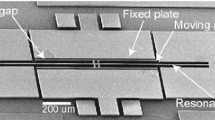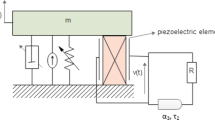Abstract
The purpose of this work is to analyze the optimality of pulsed actuations of leaky resonators when the ratio between the resonator and sampling frequencies is irrational. This is the case when the actuation system and resonator are non-synchronized or uncoupled. It will be proven that any bounded pulsed actuation of a leaky resonator cannot be optimal for maximizing the energy of a leaky resonator from a certain time onwards. Therefore sustained optimal energy transfer to a resonator will require a certain degree of coupling between the actuation system and the resonator, allowing their respective frequencies to have a rational proportionality.

Similar content being viewed by others
Abbreviations
- 〈x,y〉:
-
Scalar product in ℝn
- ⌈a⌉:
-
minimum integer greater or equal to a, a∈ℝ
- \(R_{S}^{n\times n}\) :
-
Space of n×n symmetric real matrices
- v T :
-
Transpose of v∈ℝn
- sgn(a):
-
Sign function, a∈ℝ
References
H. Bruin, J.H.B. Deane, Piecewise contractions are asymptotically periodic. Proc. Am. Math. Soc. 137(4), 1389–1395 (2009)
E. Colinet, J. Juillard, S. Guessab, R. Kielbasa, Actuation of resonant MEMS using short pulsed forces. Sens. Actuators A, Phys. 115(1), 118–125 (2004). doi:10.1016/j.sna.2004.04.004
M. Dominguez, Energy efficiency of pulsed actuations on linear resonators. IEEE Trans. Circuits Syst. I, Regul. Pap. 56(12), 2678–2688 (2009)
M. Dominguez, J. Pons, J. Ricart, E. Figueras, The MEMS pulsed digital oscillator (pdo) below the Nyquist limit. Sens. Actuators A, Phys. 136(2), 690–696 (2007). doi:10.1016/j.sna.2006.12.020
M. Dominguez, J. Pons-Nin, J. Ricart, General dynamics of pulsed digital oscillators. IEEE Trans. Circuits Syst. I, Regul. Pap. 55(7), 2038–2050 (2008). doi:10.1109/TCSI.2008.918175
K. Falconer, The Geometry of Fractal Sets (Cambridge University Press, Cambridge, 1985)
G. Lee, N. Tam, N. Yen, Quadratic Programming and Affine Variational Inequalities (Springer, Berlin, 2005)
J. Lee, S. Lucyszyn, A micromachined refreshable braille cell. J. Microelectromech. Syst. 14(4), 673–682 (2005). doi:10.1109/JMEMS.2005.845415
O.L. Mangasarian, Locally unique solutions of quadratic programs, linear and nonlinear complementarity problems. Math. Program. 19, 200–212 (1980)
J. Ricart, J. Pons, M. Dominguez, A. Rodriguez, E. Figueras, M. Horrillo, J. Gutierrez, I. Sayago, Application of pulsed digital oscillators to volatile organic compounds sensing. Sens. Actuators B, Chem. 134(2), 773–779 (2008)
J. Wu, L. Carley, Electromechanical delta; sigma; modulation with high-q micromechanical accelerometers and pulse density modulated force feedback. IEEE Trans. Circuits Syst. I, Regul. Pap. 53(2), 274–287 (2006). doi:10.1109/TCSI.2005.857084
G.M. Zaslavsky, Hamiltonian Dynamics and Fractional Dynamics (Oxford University Press, London, 2008)
Author information
Authors and Affiliations
Corresponding author
Appendix: Analysis of S 3 sequences
Appendix: Analysis of S 3 sequences
NOTE: In this Appendix, 〈⋅〉 and 〈⋅〉 a refer to the modulus 1 and modulus a operations, respectively. S 3 sequences are the Sign of a Sampled Sinusoid sequences.
We may define the set \(\mathcal{S}^{3}\) as the set of all unordered pairs {s,−s}, where s is a S 3 sequence. We may also define the set \(\mathcal{SD}\) as the set of all first-order sigma-delta (SD) sequences. It was proven in [5] that a bijection exists between these two sets. This means, that S 3 sequences may be analyzed by analyzing SD sequences.
Given a pair \(\{s,-s\}\in\mathcal{S}^{3}\), the sequence s can be expressed in the form:
with f∈[0,1/2) and λ∈[0,1/2) (if λ needs to be in [1/2,1), then −s will have λ in the desired segment). The pair \(\{s,-s\}\in\mathcal{S}^{3}\) may be linked to the following SD sequence:
with x=2f∈(0,1) and x 0=2λ∈(0,1). Since we are interested in S 3 sequences of irrational frequency we will consider x irrational. We will prove the following result:
Lemma 2
For any sigma-delta sequence of irrational frequency, b, there exists a strictly increasing sequence (l k ) of natural numbers, such that the number of possible different combinations of l k consecutive bits of b is less or equal than \(l_{k}^{2}\).
Proof
Any sigma-delta sequence may expressed in the form (36) for some x and x 0. If we define the sequence u n =〈nx+x 0〉 it is clear that u n ∈(0,1), since x is irrational, and that b n =x+u n−1−u n . We may also define the scale of the sigma-delta sequence as S 0=Sup{u n }=1, and Δ 0=x. For the sake of unifying notation we further define sequence b (0)=b. Now, with these definitions in mind, we may rewrite (36) as
Any first-order sigma-delta sequences (with Δ 0/S 0≠1/2) has either more ‘1’s than ‘0’, or more ‘0’s than ‘1’s. Therefore for each sequence there is a minority symbol (‘0’ or ‘1’) and a majority symbol (‘1’ or ‘0’). The number of majority symbols between two consecutive minority symbols will be either L 0−1 or L 0−2, where L 0=⌈S 0/Δ 0⌉, if Δ 0/S 0<1/2, and ⌈S 0/(S 0−Δ 0)⌉ otherwise.
This means that any sigma-delta sequence is formed by a succession of ‘large symbols’ (L 0−1 majority symbols and a minority symbol) and ‘small symbols’ (L 0−2 majority symbols and a minority symbol). By associating a ‘0’ to the large symbols and a ‘1’ to the small ones, we generate a second binary sequence that it is also a sigma-delta sequence. This procedure can be iterated indefinitely giving as a result a succession of non trivial sigma-delta sequences, since x is irrational:
where for k≥0 it is S k+1=Δ k , \(\varDelta_{k+1}=\langle L_{k}\varDelta_{k}\rangle_{S_{k}}\), \(L_{k+1}= \lceil\frac{S_{k}}{\varDelta_{k}} \rceil\), if Δ k /S k <1/2; and \(S_{k+1}=S_{k}-\varDelta_{k}=\langle-\varDelta_{k}\rangle_{S_{k}}\), \(\varDelta_{k+1}=\langle-L_{k}\varDelta_{k}\rangle_{S_{k}}\), \(L_{k+1}= \lceil\frac{S_{k}}{S_{k}-\varDelta_{k}} \rceil\) otherwise.
With the above procedure, the symbols of the first sequence, \(b_{n}^{(0)}\), are simple ‘0’s and ‘1’s. The bits of the second chain, \(b_{n}^{(1)}\), are related to chains of bits of the first sequence of length L 0 or L 0−1 bits. The bits of the third chain, \(b_{n}^{(2)}\), are related to chains of bits of the second sequence of length L 1 or L 1−1, and so forth. Now, given a specific chain, \(b_{n}^{(k)}\), its long chain of bits will be formed by L k bits and its short ones by L k −1 bits. A long chain may present L 0+1 different combinations, whereas a short one may present only L 0. Therefore we may ensure that there is a sequence of numbers L 0,L 1,L 2,… such that any (L 0−1)(L 1−1)(L 2−1)⋯(L k −1) take at most (L 0+1)(L 1+1)(L 2+1)⋯(L k +1) different values. Since L k >2 for all k, it means that any l k =(L 0−1)(L 1−1)(L 2−1)⋯(L k −1) consecutive bits of the original chain may takes less or equal than \(l_{k}^{2}\) different values. □
Corollary 3
For any S 3 sequence of irrational frequency, b, there exists a strictly increasing sequence (l k ) of natural numbers, such that the number of possible different combinations of l k consecutive bits of b is less than or equal to \(2l_{k}^{2}\).
Proof
It is obvious since any unordered pair of S 3 sequences \((s,-s)\in\mathcal{S}^{3}\) may be linked to a specific first-order sigma-delta sequence with a bijection. □
Rights and permissions
About this article
Cite this article
Domínguez-Pumar, M. Energy Efficiency of Non-synchronized Pulsed Actuations on Leaky Resonators. Circuits Syst Signal Process 32, 1659–1672 (2013). https://doi.org/10.1007/s00034-012-9525-8
Received:
Revised:
Published:
Issue Date:
DOI: https://doi.org/10.1007/s00034-012-9525-8




